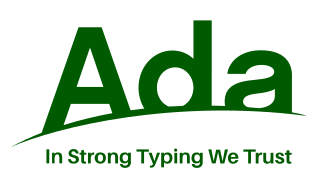
Ada is a structured, statically typed, imperative, and object-oriented high-level programming language, inspired by Pascal and other languages. It has built-in language support for design by contract (DbC), extremely strong typing, explicit concurrency, tasks, synchronous message passing, protected objects, and non-determinism. Ada improves code safety and maintainability by using the compiler to find errors in favor of runtime errors. Ada is an international technical standard, jointly defined by the International Organization for Standardization (ISO), and the International Electrotechnical Commission (IEC). As of May 2023, the standard, called Ada 2022 informally, is ISO/IEC 8652:2023.
CORAL, short for Computer On-line Real-time Applications Language is a programming language originally developed in 1964 at the Royal Radar Establishment (RRE), Malvern, Worcestershire, in the United Kingdom. The R was originally for "radar", not "real-time". It was influenced primarily by JOVIAL, and thus ALGOL, but is not a subset of either.
A "Hello, World!" program is generally a simple computer program which outputs to the screen a message similar to "Hello, World!" while ignoring any user input. A small piece of code in most general-purpose programming languages, this program is used to illustrate a language's basic syntax. A "Hello, World!" program is often the first written by a student of a new programming language, but such a program can also be used as a sanity check to ensure that the computer software intended to compile or run source code is correctly installed, and that its operator understands how to use it.

Simula is the name of two simulation programming languages, Simula I and Simula 67, developed in the 1960s at the Norwegian Computing Center in Oslo, by Ole-Johan Dahl and Kristen Nygaard. Syntactically, it is an approximate superset of ALGOL 60, and was also influenced by the design of Simscript.
A straw-man proposal is a brainstormed simple draft proposal intended to generate discussion of its disadvantages and to spur the generation of new and better proposals. The term is considered American business jargon, but it is also encountered in engineering office culture.

Ole-Johan Dahl was a Norwegian computer scientist. Dahl was a professor of computer science at the University of Oslo and is considered to be one of the fathers of Simula and object-oriented programming along with Kristen Nygaard.
This is a "genealogy" of programming languages. Languages are categorized under the ancestor language with the strongest influence. Those ancestor languages are listed in alphabetic order. Any such categorization has a large arbitrary element, since programming languages often incorporate major ideas from multiple sources.
A compiled language is a programming language whose implementations are typically compilers, and not interpreters.
In computer science, a high-level programming language is a programming language with strong abstraction from the details of the computer. In contrast to low-level programming languages, it may use natural language elements, be easier to use, or may automate significant areas of computing systems, making the process of developing a program simpler and more understandable than when using a lower-level language. The amount of abstraction provided defines how "high-level" a programming language is.
JOVIAL is a high-level programming language based on ALGOL 58, specialized for developing embedded systems. It was a major system programming language through the 1960s and 1970s.

The history of programming languages spans from documentation of early mechanical computers to modern tools for software development. Early programming languages were highly specialized, relying on mathematical notation and similarly obscure syntax. Throughout the 20th century, research in compiler theory led to the creation of high-level programming languages, which use a more accessible syntax to communicate instructions.
In computer programming, a statement is a syntactic unit of an imperative programming language that expresses some action to be carried out. A program written in such a language is formed by a sequence of one or more statements. A statement may have internal components.
Modular programming is a software design technique that emphasizes separating the functionality of a program into independent, interchangeable modules, such that each contains everything necessary to execute only one aspect of the desired functionality.
In computer science, a relational operator is a programming language construct or operator that tests or defines some kind of relation between two entities. These include numerical equality and inequalities.

Jean David Ichbiah was a French computer scientist and the initial chief designer (1977–1983) of Ada, a general-purpose, strongly typed programming language with certified validated compilers.
Programming languages are used for controlling the behavior of a machine. Like natural languages, programming languages follow rules for syntax and semantics.




